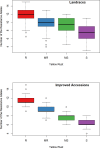Evaluation of a global spring wheat panel for stripe rust: Resistance loci validation and novel resources identification
- PMID: 31721783
- PMCID: PMC6853611
- DOI: 10.1371/journal.pone.0222755
Evaluation of a global spring wheat panel for stripe rust: Resistance loci validation and novel resources identification
Abstract
Stripe rust (incited by Puccinia striiformis f. sp. tritici) is airborne wheat (Triticum aestivum L.) disease with dynamic virulence evolution. Thus, anticipatory and continued screening in hotspot regions is crucial to identify new pathotypes and integrate new resistance resources to prevent potential disease epidemics. A global wheat panel consisting of 882 landraces and 912 improved accessions was evaluated in two locations in Egypt during 2016 and 2017. Five prevalent and aggressive pathotypes of stripe rust were used to inoculate the accessions during the two growing seasons and two locations under field conditions. The objectives were to evaluate the panel for stripe rust resistance at the adult plant stage, identify potentially novel QTLs associated with stripe rust resistance, and validate previously reported stripe rust QTLs under the Egyptian conditions. The results indicated that 42 landraces and 140 improved accessions were resistant to stripe rust. Moreover, 24 SNPs were associated with stripe rust resistance and were within 18 wheat functional genes. Four of these genes were involved in several plant defense mechanisms. The number of favorable alleles, based upon the associated SNPs, was significant and negatively correlated with stripe rust resistance score, i.e., as the number of resistances alleles increased the observed resistance increased. In conclusion, generating new stripe rust phenotypic information on this panel while using the publicly available molecular marker data, contributed to identifying potentially novel QTLs associated with stripe rust and validated 17 of the previously reported QTLs in one of the global hotspots for stripe rust.
Conflict of interest statement
The authors have declared that no competing interests exist.
Figures







References
-
- Yuan FP, Zeng QD, Wu JH, Wang QL, Yang ZJ, Liang BP, et al. QTL mapping and validation of adult plant resistance to stripe rust in chinese wheat landrace humai 15. Front Plant Sci [Internet]. 2018. [cited 2018 Oct 30];9(July):1–13. Available from: http://www.ncbi.nlm.nih.gov/pubmed/30026752 - PMC - PubMed
-
- Dracatos PM, Zhang P, Park RF, McIntosh RA, Wellings CR. Complementary resistance genes in wheat selection ‘Avocet R’ confer resistance to stripe rust. Theor Appl Genet [Internet]. 2016. January 3 [cited 2018 Oct 8];129(1):65–76. Available from: http://www.ncbi.nlm.nih.gov/pubmed/26433828 10.1007/s00122-015-2609-7 - DOI - PubMed
-
- Wabila C, Neumann K, Kilian B, Radchuk V, Graner A. A tiered approach to genome-wide association analysis for the adherence of hulls to the caryopsis of barley seeds reveals footprints of selection. BMC Plant Biol [Internet]. 2019. December 6 [cited 2019 Apr 12];19(1):95 Available from: 10.1186/s12870-019-1694-1 - DOI - PMC - PubMed
-
- Dangl JL, Horvath DM, Staskawicz BJ. Pivoting the plant immune system from dissection to deployment [Internet]. Vol. 341, Science. NIH Public Access; 2013. [cited 2018 Oct 8]. p. 746–51. Available from: http://www.ncbi.nlm.nih.gov/pubmed/23950531 10.1126/science.1236011 - DOI - PMC - PubMed
Publication types
MeSH terms
LinkOut - more resources
Full Text Sources

